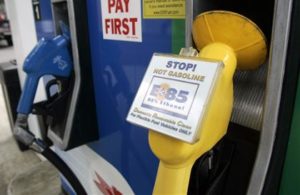The move does not affect special E-85 fuel — an 85% ethanol/gas blend not considered gasoline at all — already allowed by the EPA. E-85, sold mostly in the Midwest, only can be used in vehicles designed as “flex fuel” machines, to take the higher concentration of more-corrosive ethanol without damage.
EPA says thorough testing has shown E-15 won’t cause problems in the newer vehicles.
Even though the E-15 blend is intended for cars and trucks — indeed, it’s technically illegal to use it in other engines — the small-engine lobby figures it’ll nevertheless wind up in the hundreds of millions of chainsaws, leaf blowers, law mowing equipment, boats, all-terrain vehicles and the like.
[ad]
It’s unlikely that a station would sell both E-10 and E-15, and even more unlikely that a motorist would fill up the car at at E-15 station (where the higher blend of ethanol will make the fuel a little cheaper), then search out an E-10 or straight-gasoline station to fill the lawn mower gas can, says Kris Kiser, executive vice president of the Outdoor Power Equipment Institute.
E-15 “will get into products it shouldn’t, and there’ll be lawsuits,” he predicts.
“The new ethanol blends, known as E-15, come with serious risks for our engines, wildlife, water, and the air we all breathe,” warns Nathanael Greene at the Natural Resources Defense Council, an environmental activist group.
“A broad coalition of environmentalists, public health advocates, livestock ranchers, and automakers have long opposed EPA’s move,” he says. “Burning ethanol can cause toxic air pollutants to be emitted from vehicle tailpipes, especially at higher blend levels like E-15. The chemistry is fairly straightforward: ethanol burns hotter than gasoline, causing catalytic converters to break down faster.”
The government hinted that the E-15 rule will be broadened. EPA Administrator Lisa Jackson said Wednesday’s action was “the first of a number of actions that are needed from federal, state and industry toward commercialization of E-15 gasoline blends.” She noted that “a decision on the use of E-15 in model year 2001 to 2006 vehicles will be made after EPA receives the results of additional DOE testing, which is expected to be completed in November.”
Kiser, of the Outdoor Equipment group, says it won’t stop there: “We’ll have the same conversation six months from now about E-20. E-15 doesn’t get you anywhere near the flex-fuel mandate set by Congress; E-15 only buys you a little time.”
EPA is under a rural-state-promoted congressional mandate to increase ethanol use. Congress required fuel refiners to blend 36 billion gallons of biofuels, mostly ethanol, into auto fuel by 2022 and the EPA says it can’t be done without allowing at least an E-15 blend.
Most ethanol is made from corn in this country, and farm states have strongly pushed for the government to promote more use of it.
Beyond possible damage to engines, opponents say E-15 is a bad idea because:
— Growing more corn and using it for ethanol instead of animal feed will make feed (and thus meat) costly and inflate supermarket prices for the wide range of foods containing corn products.
— It can be seen as bad use of land and a promotion of wasteful, energy-intensive agriculture.
Roland Hwang of the NRDC says: “We strongly support ethanol, as long as it comes from sustainable feedstock and it’s used in a manner that doesn’t undermine air quality. Unfortunately, corn ethanol used as E-15 fails on both counts.
“Corn ethanol is clearly not sustainable and the E-15 (rule) will increase air pollution due to misfueling.”
Ethanol industry group Growth Energy petitioned the EPA earlier this year to allow E-15. The decision has been delayed twice as the EPA and Energy Department did more testing.
The Obama administration’s decision to allow E-15 is a win for the ethanol industry as it faces losing its generous government subsidies. A key tax credit is to expire Dec. 31 and there’s been opposition in Congress to renewing it.
Source and image USAToday.com


